The award-winning painter, Steve Curl, teaches you how to paint a boat on a shimmery lake using classic watercolor techniques such as the "wet-in-wet" technique (also called the "variegated wash" technique). Want to watch the video version? The full tutorial is available to members of our Beeblys WatercolorPainting.com.
Materials Used In This Watercolor Class:
- A sheet of Arches cold press watercolor paper (140lb, size 12″ x 8″)
- HB or 2B pencil
- Kneaded eraser
- Ruler
- Painting palette for watercolor paints
- A container of water
- A towel or rag to rest brushes on
- Tissue or paper towels
- A credit card, or anything with a thin but strong plastic edge
Paints (Holbein Artists' Watercolors)
- Lemon Yellow
- Auhttps://amzn.to/3SFwQ9breolin
- Cadmium Yellow Light
- Cadmium Yellow Orange
- Cadmium Red Purple
- Permanent Violet
- Greenish Yellow
- Sap Green
- Hooker's Green
- Cadmium Green Deep
- Cerulean Blue
- Cobalt Blue Hue
- Ultramarine Deep
- Burnt Sienna
- Payne's Gray
- Neutral Tint
Brushes
- Silver Brush Black Velvet: Jumbo Round mop brush (medium)
- Stratford & York Warwick Series: Round sable brush (size 6)
- Stratford & York Warwick Series: Round sable brush (size 8)
- Stratford & York Warwick Series: Round sable brush (size 12)
- Large flat brush with a clean edge
Step 1: Sketching The Scene
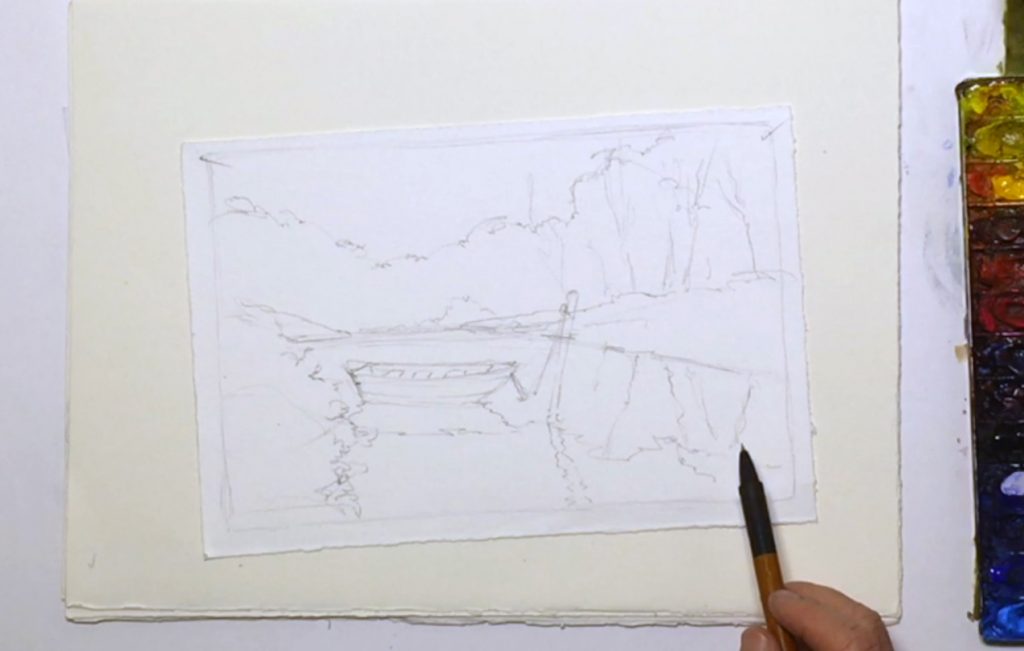 To start, use a ruler and pencil to draw a 1/2" border around the edges of your paper, giving you a margin for any future framing you may get when your painting is done. This “window” will help determine what ends up inside your composition. Begin your composition sketch by lightly drawing a horizon line where the lake meets the sky, some shrubs on the right side of the bank, and a large tree in the mid- to bottom-left corner to serve as a foreground element. Complete the land on both sides of the lake by framing the water with a slight diagonal line, then add a forest in the background to increase the sense of depth in your sketch. Next, place a rowboat in the middle of the water near the foreground tree, paying attention to the placement of the surrounding foliage and the overall size of the lake. Add additional details such as the shapes of "windows" in the trees created by gaps in the branches, a pole in the water to tie the rowboat to, and the reflections of the boat and trees. Note that all the reflections should be mirror-images of their counterpart. One important tip to remember is that you're trying to create shapes that are visually engaging and interesting, not drawing every single detail as realistically as possible. But when you're satisfied with the sketch, you're ready for the fun part: painting! Below is a close-up of Steve's compositional sketch:
To start, use a ruler and pencil to draw a 1/2" border around the edges of your paper, giving you a margin for any future framing you may get when your painting is done. This “window” will help determine what ends up inside your composition. Begin your composition sketch by lightly drawing a horizon line where the lake meets the sky, some shrubs on the right side of the bank, and a large tree in the mid- to bottom-left corner to serve as a foreground element. Complete the land on both sides of the lake by framing the water with a slight diagonal line, then add a forest in the background to increase the sense of depth in your sketch. Next, place a rowboat in the middle of the water near the foreground tree, paying attention to the placement of the surrounding foliage and the overall size of the lake. Add additional details such as the shapes of "windows" in the trees created by gaps in the branches, a pole in the water to tie the rowboat to, and the reflections of the boat and trees. Note that all the reflections should be mirror-images of their counterpart. One important tip to remember is that you're trying to create shapes that are visually engaging and interesting, not drawing every single detail as realistically as possible. But when you're satisfied with the sketch, you're ready for the fun part: painting! Below is a close-up of Steve's compositional sketch: 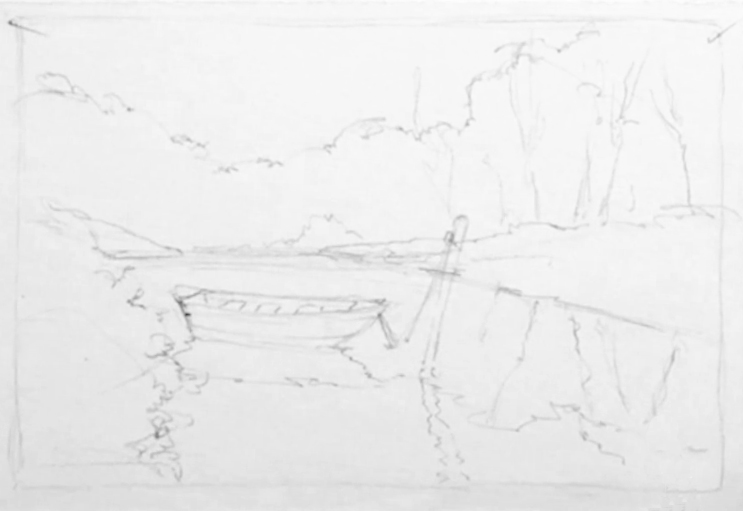
Step 2: Painting The Sky Using The "Wet-In-Wet" Technique
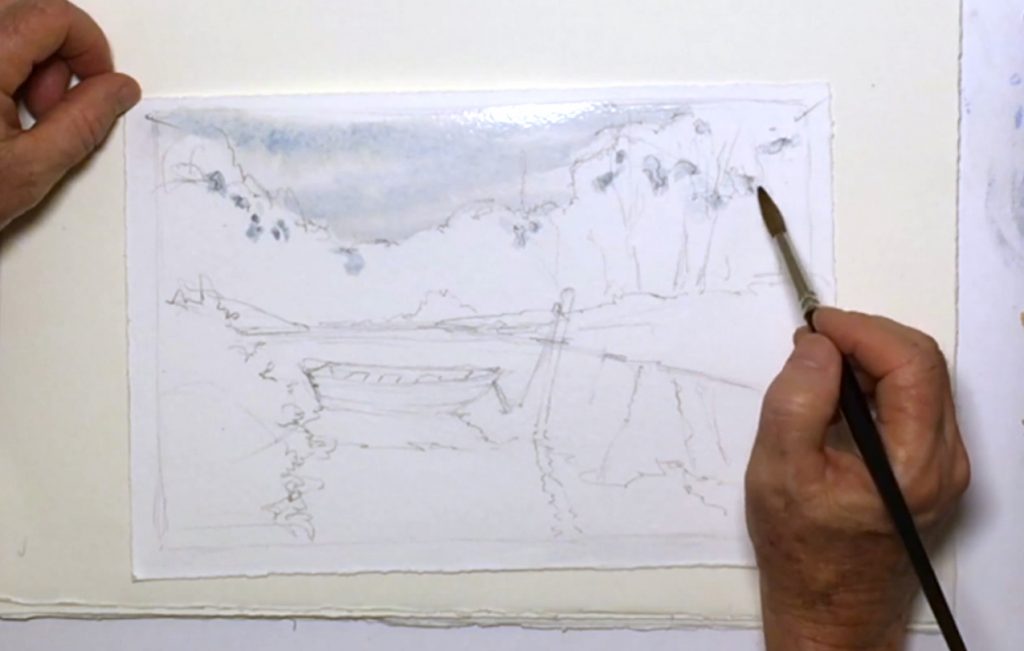 As a general rule, Steve advises to paint from background to foreground, and from light to dark. This will help speed up the painting process while minimizing the chances of making mistakes. So begin by taking the Black Velvet mop brush and wetting the sky area with clean water. Then, mix a sky color on the palette using a diluted Cerulean Blue with a touch of Greenish Yellow, which will help set the mood of your painting. While the paper is still wet, gently brush in the paint with the size 12 round sable brush, leaving soft white streaks for clouds. Don't forget to apply the paint within each of the “windows” in the trees, as gaps in the foliage will reveal the sky behind it.
As a general rule, Steve advises to paint from background to foreground, and from light to dark. This will help speed up the painting process while minimizing the chances of making mistakes. So begin by taking the Black Velvet mop brush and wetting the sky area with clean water. Then, mix a sky color on the palette using a diluted Cerulean Blue with a touch of Greenish Yellow, which will help set the mood of your painting. While the paper is still wet, gently brush in the paint with the size 12 round sable brush, leaving soft white streaks for clouds. Don't forget to apply the paint within each of the “windows” in the trees, as gaps in the foliage will reveal the sky behind it.
Step 3: The Rowboat's First Layer
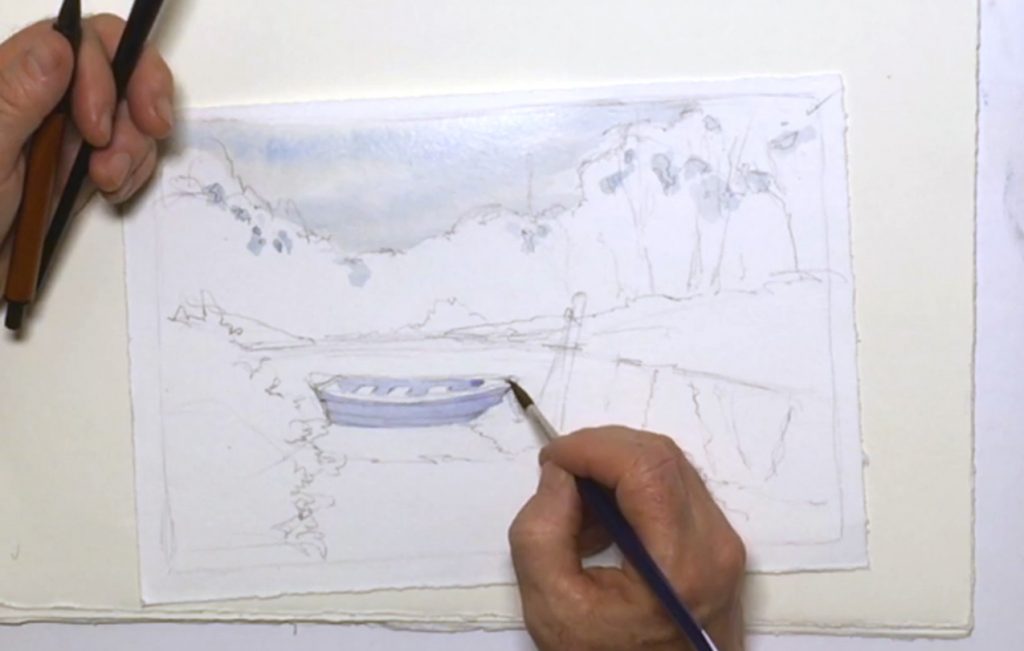 Shift your focus to the rowboat, using the pencil to sketch in any missing details such as the boat's bow, dividing lines for different colored stripes on the outside, and any important shadow or highlight shapes that will give structure and depth to the boat. As the light source is coming from above, the gunnels (i.e. the upper edge of a boat) and the seat slats inside must have a thickness to their edges, so make sure to draw them in. On the other hand, the outside and inside walls of the boat will be in shadow, so paint them with a diluted Ultramarine Deep mixed with a little Sap Green, making sure not to touch the seats or the gunnels. You can switch to the size 6 brush for the inside area, and be sure to use light brushstrokes as not to “overflow” the boat with blue.
Shift your focus to the rowboat, using the pencil to sketch in any missing details such as the boat's bow, dividing lines for different colored stripes on the outside, and any important shadow or highlight shapes that will give structure and depth to the boat. As the light source is coming from above, the gunnels (i.e. the upper edge of a boat) and the seat slats inside must have a thickness to their edges, so make sure to draw them in. On the other hand, the outside and inside walls of the boat will be in shadow, so paint them with a diluted Ultramarine Deep mixed with a little Sap Green, making sure not to touch the seats or the gunnels. You can switch to the size 6 brush for the inside area, and be sure to use light brushstrokes as not to “overflow” the boat with blue.
Step 4: Painting A Forest Using The "Variegated Wash" Technique
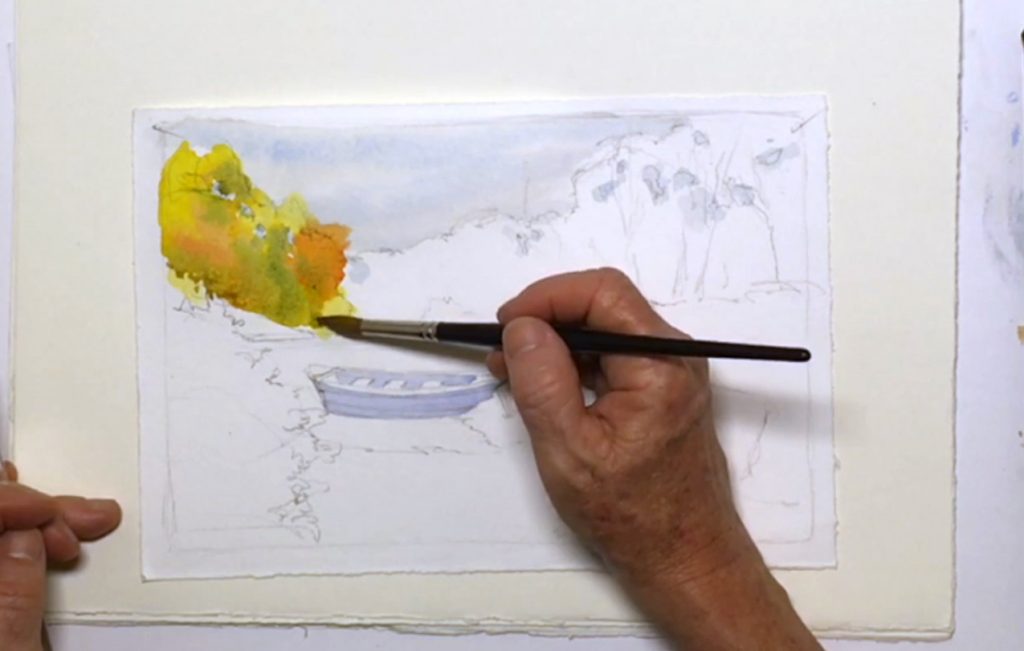 Give the boat some space to dry, and start working on the trees. Remember that watercolor is a transparent medium, which is why it's better to paint from light to dark as lighter colors are easily covered by darker ones. To create a fall-themed foliage with a golden tint, use the size 12 brush and mix Cadmium Yellow Light, Lemon Yellow, and Aureolin, then starting from the left, paint about a third of the forest while being careful to avoid painting over the "windows" in the trees. Work in sections as you'll be using the variegated wash technique (a variation of the wet-in-wet technique) later on, which will only work while your paint is still wet. To do so, drop in a mixture of Cadmium Red Purple and Yellow Orange in the wet yellow paint, with a touch of Burnt Sienna to darken areas that have more shadow or areas that feel too bright. You can also mix a warm green color using Sap and Hooker’s Green with Burnt Sienna to tone down the green, and add it to your variegated wash to increase the variation of colors in the forest while adding a "late September" feeling. Additionally, try to create a structural shape within the trees each time you switch colors. Wiggling your brush to make leafy shapes or adding hints of leaves here and there will help.
Give the boat some space to dry, and start working on the trees. Remember that watercolor is a transparent medium, which is why it's better to paint from light to dark as lighter colors are easily covered by darker ones. To create a fall-themed foliage with a golden tint, use the size 12 brush and mix Cadmium Yellow Light, Lemon Yellow, and Aureolin, then starting from the left, paint about a third of the forest while being careful to avoid painting over the "windows" in the trees. Work in sections as you'll be using the variegated wash technique (a variation of the wet-in-wet technique) later on, which will only work while your paint is still wet. To do so, drop in a mixture of Cadmium Red Purple and Yellow Orange in the wet yellow paint, with a touch of Burnt Sienna to darken areas that have more shadow or areas that feel too bright. You can also mix a warm green color using Sap and Hooker’s Green with Burnt Sienna to tone down the green, and add it to your variegated wash to increase the variation of colors in the forest while adding a "late September" feeling. Additionally, try to create a structural shape within the trees each time you switch colors. Wiggling your brush to make leafy shapes or adding hints of leaves here and there will help.
Step 5: Using A Scraping Technique To Create Tree Trunks Within A Forest
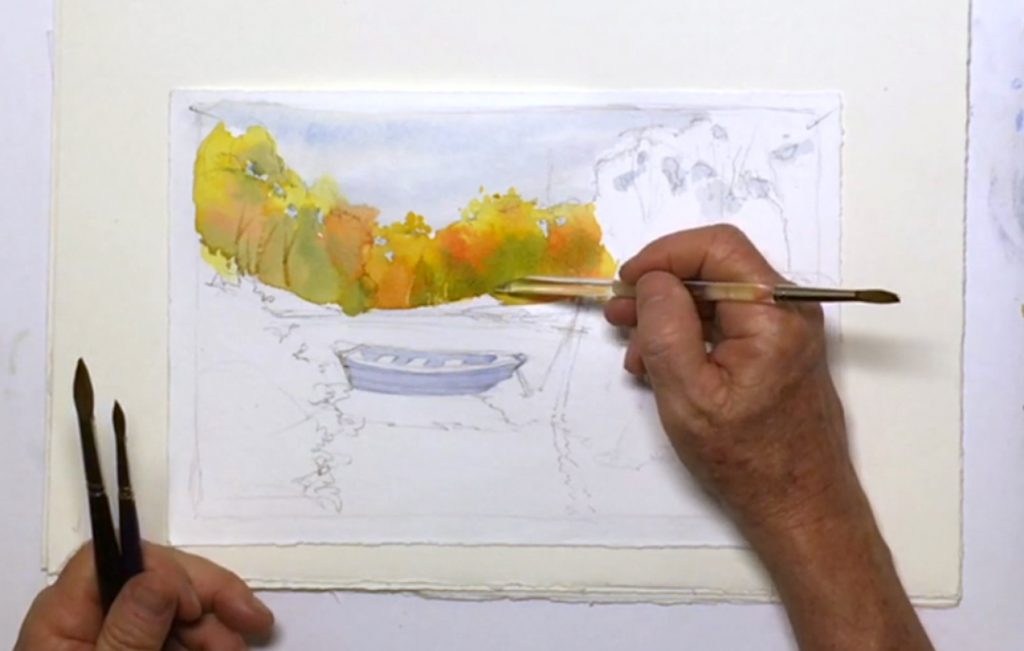 When you finish the left area of trees, move to the middle section of the background forest. Add more Cadmium Yellow Light into the previous red mixture, and use this color to paint in more structural branches and leaves along the top of the forest. For the main section, use the same method described in step 4, making sure to "melt in" and bleed the colors into one another without muddying them, which will happen if you try to mix too much paint in one spot. You should have a vibrant, organic feeling to your trees. Before the paint completely dries, go back to the first section of trees and use a scraping tool - either the corner of a credit card or otherwise - and scrape from the bottom of the forest to the top, creating grooves in the paper. Paint will collect in these grooves, and will dry darker than the surrounding color, making it the perfect method to "draw" tree trunks and branches within your forest. Make sure to wipe the plastic edge with a paper towel after each scrape, as you don't want paint to collect on the tool. If the paint has dried too much to scrape effectively, go over the area you want to scrape with more paint (blend the paint into the existing colors), wait a moment until the paint is paste-like in appearance, then scrape as needed. Try not to scrape when the paint is too wet either, as doing so will produce a less prominent textural effect.
When you finish the left area of trees, move to the middle section of the background forest. Add more Cadmium Yellow Light into the previous red mixture, and use this color to paint in more structural branches and leaves along the top of the forest. For the main section, use the same method described in step 4, making sure to "melt in" and bleed the colors into one another without muddying them, which will happen if you try to mix too much paint in one spot. You should have a vibrant, organic feeling to your trees. Before the paint completely dries, go back to the first section of trees and use a scraping tool - either the corner of a credit card or otherwise - and scrape from the bottom of the forest to the top, creating grooves in the paper. Paint will collect in these grooves, and will dry darker than the surrounding color, making it the perfect method to "draw" tree trunks and branches within your forest. Make sure to wipe the plastic edge with a paper towel after each scrape, as you don't want paint to collect on the tool. If the paint has dried too much to scrape effectively, go over the area you want to scrape with more paint (blend the paint into the existing colors), wait a moment until the paint is paste-like in appearance, then scrape as needed. Try not to scrape when the paint is too wet either, as doing so will produce a less prominent textural effect.
Step 6: Adding Highlights
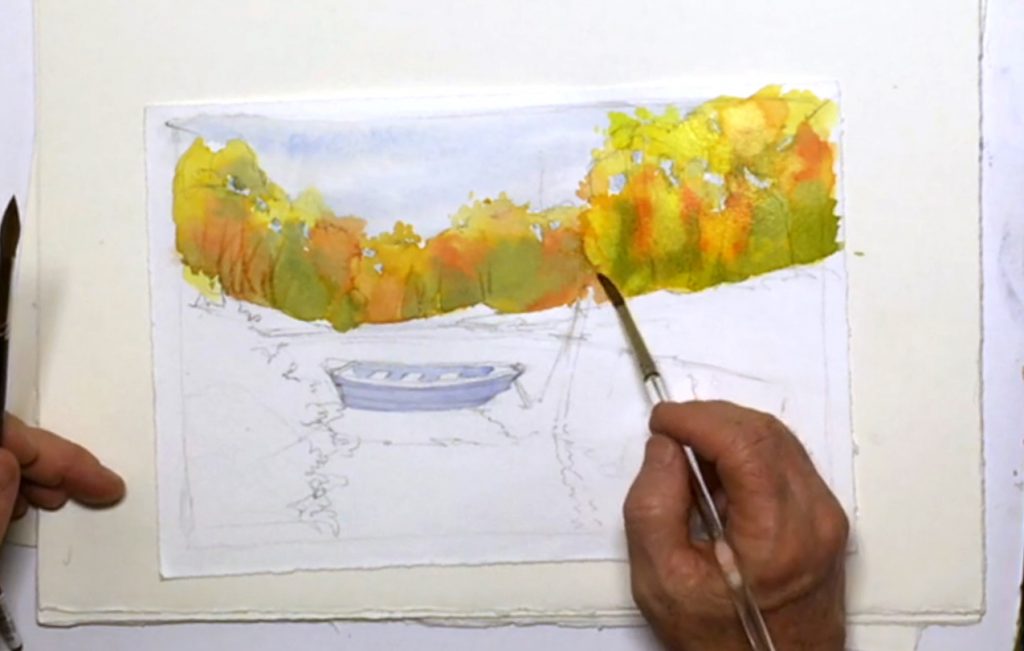 Move to the last section of trees on the right side, using the same method as you did in steps 4 and 5 to keep in theme with the “fall foliage” feel. Keep checking back to the previous sections and scrape more tree trunks before the paint dries completely. If your colors get too dark, remember that wetter paint will push dryer paint more into the background (a characteristic you'll notice when using the variegated wash technique), so it's possible to drop in your yellow mixture to replace any lost highlights. Keep filling in the forest area until you're satisfied with the arrangement of colors and composition of the tree trunks and branches, and try to avoid getting the paper too wet or painting any regular shapes or patterns within the trees themselves.
Move to the last section of trees on the right side, using the same method as you did in steps 4 and 5 to keep in theme with the “fall foliage” feel. Keep checking back to the previous sections and scrape more tree trunks before the paint dries completely. If your colors get too dark, remember that wetter paint will push dryer paint more into the background (a characteristic you'll notice when using the variegated wash technique), so it's possible to drop in your yellow mixture to replace any lost highlights. Keep filling in the forest area until you're satisfied with the arrangement of colors and composition of the tree trunks and branches, and try to avoid getting the paper too wet or painting any regular shapes or patterns within the trees themselves.
Step 7: Painting A Lake Bank With The "Lost And Found" Technique
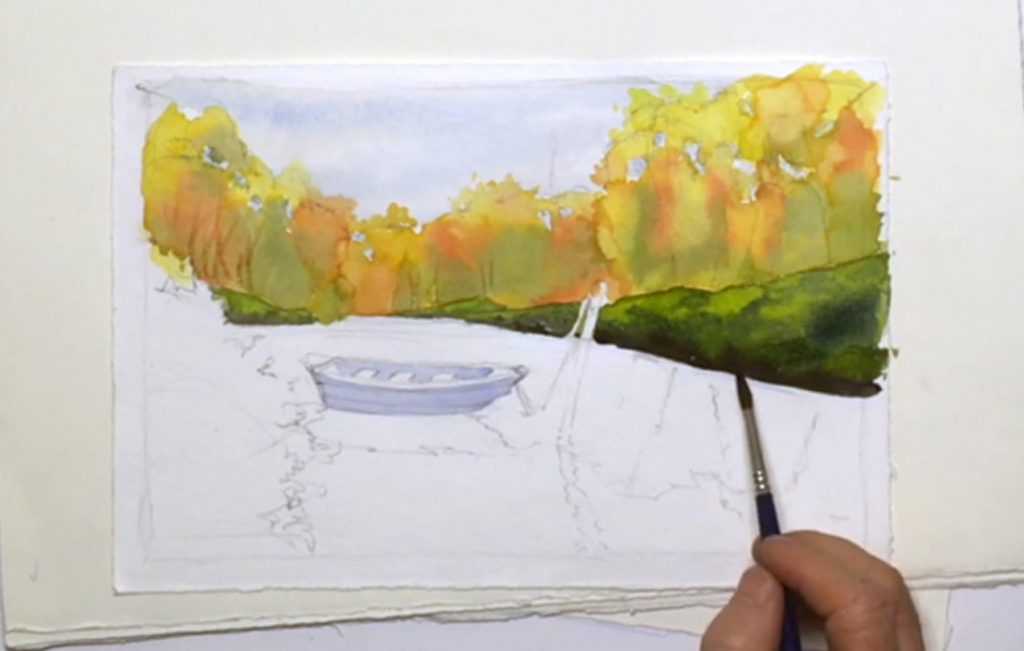 Next is painting the bank. With the size 6 or 8 round sable brush, mix Hooker's Green with Burnt Sienna to get an earthy green tone, then paint in a small grassy bank that connects with the left edge of the water. Since it's a similar color to the green in the forest, the bank may look a little "lost". To "find" it again, mix a muddy brown color using Ultramarine Deep, Alizarin Crimson, and Burnt Sienna, then drop this color in the underside of the bank while the previous layer is still wet. You can also use pure Lemon Yellow for highlights along the top of the bank. Steve calls this the “lost and found” technique, which is useful for gauging what objects should be at what distance within the painting, because even if there are similar-colored objects, their value (i.e. how light or dark something is) and saturation (i.e. how intense a color is) depends on how distant they are. When you're done with the left side, move to the right and paint in that section's base layer with the same earthy green color. Avoiding the edges of the pole and rope in the foreground will also add to your "found" effect. Keep lighting and distance in mind as you add the yellow highlights. Afterwards, mix in some Ultramarine Deep with your previous earthy green paint to get a darker version, then apply this to the middle and underside of the bank for a mid- to dark-tone color. Use the same muddy brown color for the darkest areas, adding more Alizarin Crimson and Burnt Sienna for more contrast. Add in more Sap or Hooker's Green to the shadows if the color gets too dark. This is necessary as the right side of the lake extends from the background to the front, and thus will need more details as you move to the foreground. Keep using the variegated wash technique for the banks, and always look to paint the way they're shaped while paying attention to how their edges interact with the surrounding elements.
Next is painting the bank. With the size 6 or 8 round sable brush, mix Hooker's Green with Burnt Sienna to get an earthy green tone, then paint in a small grassy bank that connects with the left edge of the water. Since it's a similar color to the green in the forest, the bank may look a little "lost". To "find" it again, mix a muddy brown color using Ultramarine Deep, Alizarin Crimson, and Burnt Sienna, then drop this color in the underside of the bank while the previous layer is still wet. You can also use pure Lemon Yellow for highlights along the top of the bank. Steve calls this the “lost and found” technique, which is useful for gauging what objects should be at what distance within the painting, because even if there are similar-colored objects, their value (i.e. how light or dark something is) and saturation (i.e. how intense a color is) depends on how distant they are. When you're done with the left side, move to the right and paint in that section's base layer with the same earthy green color. Avoiding the edges of the pole and rope in the foreground will also add to your "found" effect. Keep lighting and distance in mind as you add the yellow highlights. Afterwards, mix in some Ultramarine Deep with your previous earthy green paint to get a darker version, then apply this to the middle and underside of the bank for a mid- to dark-tone color. Use the same muddy brown color for the darkest areas, adding more Alizarin Crimson and Burnt Sienna for more contrast. Add in more Sap or Hooker's Green to the shadows if the color gets too dark. This is necessary as the right side of the lake extends from the background to the front, and thus will need more details as you move to the foreground. Keep using the variegated wash technique for the banks, and always look to paint the way they're shaped while paying attention to how their edges interact with the surrounding elements.
Step 8: Touching Up Tree Trunks
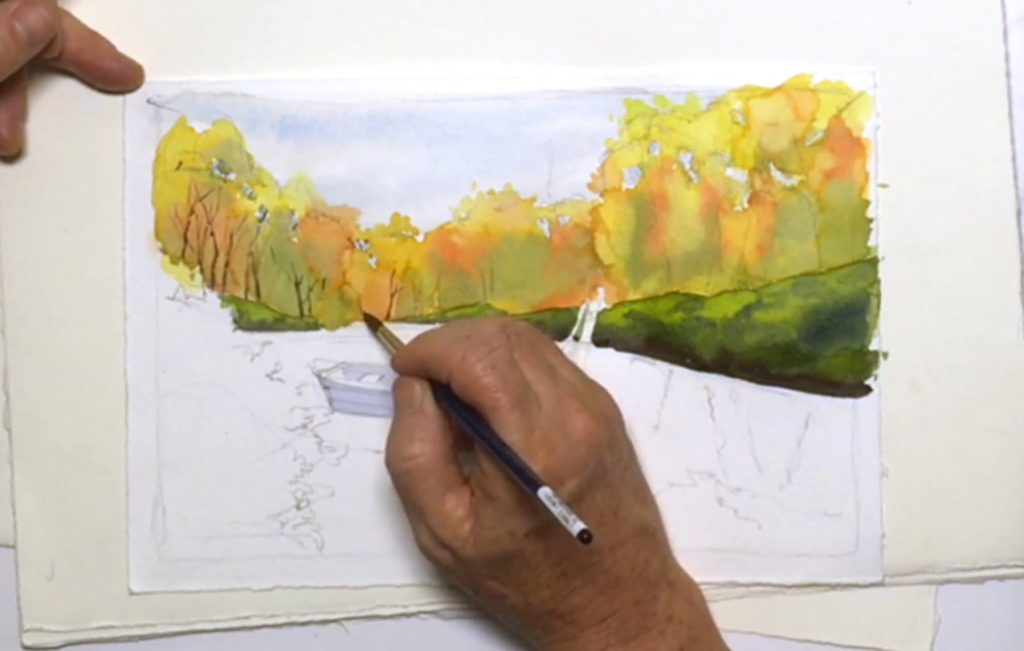 While you let the banks dry, use the size 6 brush and muddy brown paint to gently draw in a few tree trunks and branches on the left-most trees in the forest background. Be careful not to touch any wet paint, and make sure to taper the end of each brushstroke to get a good tree structure. Remember to break up any patterns that may begin to form, and don't overdo the details. You can come back to this section later to finish up the rest of the background once the paint is dry.
While you let the banks dry, use the size 6 brush and muddy brown paint to gently draw in a few tree trunks and branches on the left-most trees in the forest background. Be careful not to touch any wet paint, and make sure to taper the end of each brushstroke to get a good tree structure. Remember to break up any patterns that may begin to form, and don't overdo the details. You can come back to this section later to finish up the rest of the background once the paint is dry.
Step 9: Painting The Foreground Bush
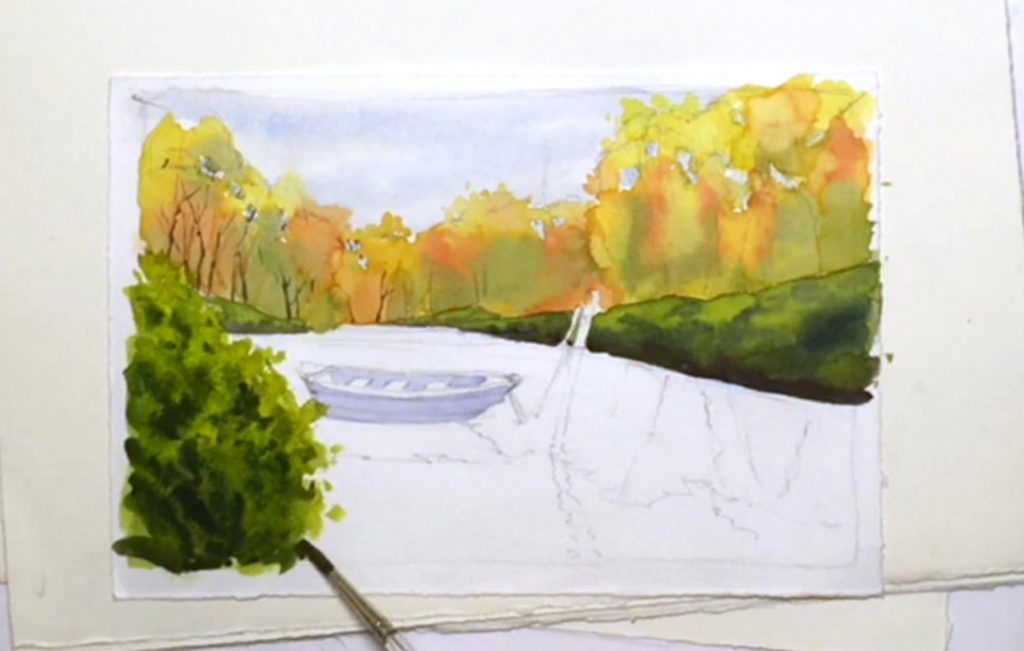 If you haven't already done so, use your pencil to sketch in the cast shadow within the bush in the foreground. Next, use the size 12 round brush and add Lemon Yellow and Aureolin into your previous earthy green mixture you used for the bank. With this light green color, paint the entire bush for its base layer. The important factor is getting the shape of the bush right, and that you're painting wet-on-dry so that the edges of your paint are hard enough to create a leaf-like border. Switch to the size 6 brush to paint the outermost leaves that branch out towards the boat or lake (it's fine to overlap a corner of the boat if you want). Dab in some Hooker's Green while the paint is still wet to get some variation in the mid-tones. Pushing a mixture of yellows into the bush will provide highlights and indicate subtle changes in light within the leaves, while adding a mixture of Hooker's Green, Ultramarine Deep, Neutral Tint, and Payne’s Gray will create shadow tones that will help make leafy patterns in your bush (the darkest shadows should be somewhat near the bottom of the bush). Allow yourself experiment with a variety of green paint to obtain a vibrant result and to create the illusion of foliage without having to paint every single leaf.
If you haven't already done so, use your pencil to sketch in the cast shadow within the bush in the foreground. Next, use the size 12 round brush and add Lemon Yellow and Aureolin into your previous earthy green mixture you used for the bank. With this light green color, paint the entire bush for its base layer. The important factor is getting the shape of the bush right, and that you're painting wet-on-dry so that the edges of your paint are hard enough to create a leaf-like border. Switch to the size 6 brush to paint the outermost leaves that branch out towards the boat or lake (it's fine to overlap a corner of the boat if you want). Dab in some Hooker's Green while the paint is still wet to get some variation in the mid-tones. Pushing a mixture of yellows into the bush will provide highlights and indicate subtle changes in light within the leaves, while adding a mixture of Hooker's Green, Ultramarine Deep, Neutral Tint, and Payne’s Gray will create shadow tones that will help make leafy patterns in your bush (the darkest shadows should be somewhat near the bottom of the bush). Allow yourself experiment with a variety of green paint to obtain a vibrant result and to create the illusion of foliage without having to paint every single leaf.
Step 10: Finishing The Fall Forest
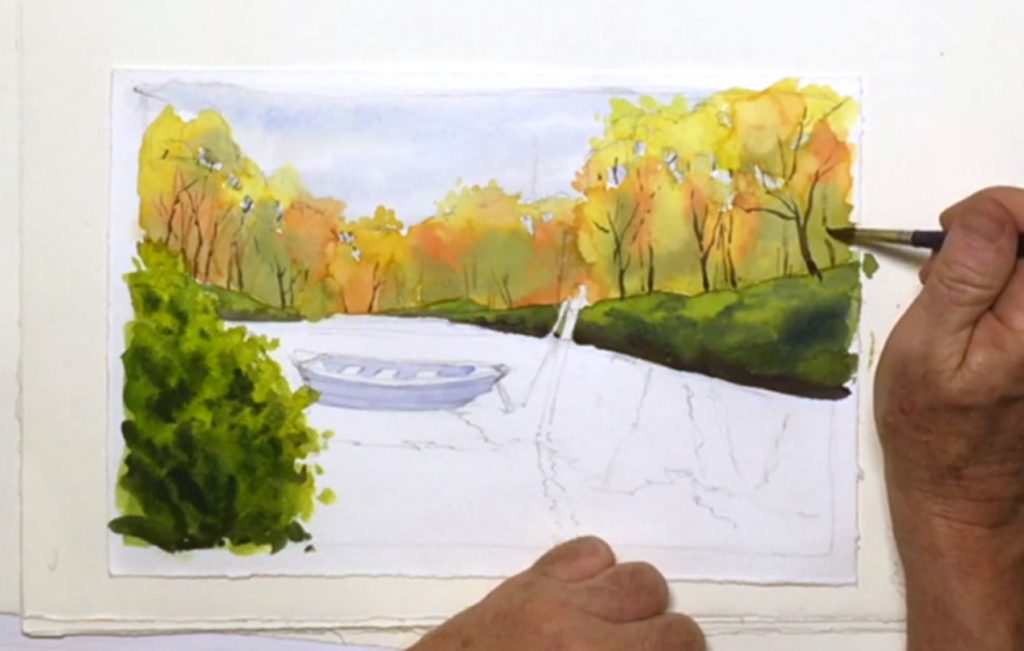 After completing most of the greenery, it's time to finish off the forest. With the small brush (size 6) and the muddy brown paint already mixed on your palette, paint all the tree trunks in the background, mixing more of the same color if necessary (refer to step 7 and 8). For more distant tree trunks, you can dilute the color and paint a few lighter-colored trunks, giving your painting more depth. Remember to taper your brushstrokes as well! You can do this by pressing slightly harder at the base of the tree, then as you move upwards, gradually lift the brush off the paper to let the tip make a nice narrow line.
After completing most of the greenery, it's time to finish off the forest. With the small brush (size 6) and the muddy brown paint already mixed on your palette, paint all the tree trunks in the background, mixing more of the same color if necessary (refer to step 7 and 8). For more distant tree trunks, you can dilute the color and paint a few lighter-colored trunks, giving your painting more depth. Remember to taper your brushstrokes as well! You can do this by pressing slightly harder at the base of the tree, then as you move upwards, gradually lift the brush off the paper to let the tip make a nice narrow line.
Step 11: How To Paint Water
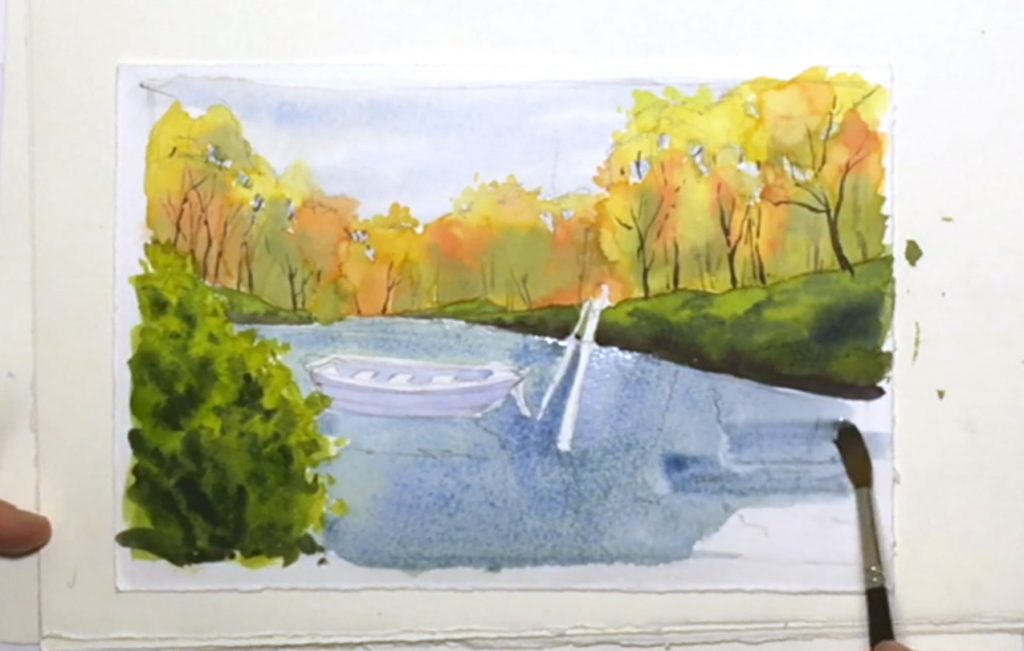 You're entering the home stretch, which means it's time to paint the water. As any large body of water will reflect the color of the sky, it is important to start off with the same color as you did when painting the sky in step 2. So clean your palette if necessary, then use the size 12 round brush to prep a diluted Cerulean Blue with a hint of Greenish Yellow and Cobalt Blue Hue. Start from the back of the lake, and lay in a wet-on-dry wash for the water around the boat. Be sure to leave the rope and wooden post unpainted, and keep a little white edge for the gunnel. When you get towards the foreground, use the wet-in-wet technique to blend in more Cobalt Blue Hue with the Cerulean color to create more depth.
You're entering the home stretch, which means it's time to paint the water. As any large body of water will reflect the color of the sky, it is important to start off with the same color as you did when painting the sky in step 2. So clean your palette if necessary, then use the size 12 round brush to prep a diluted Cerulean Blue with a hint of Greenish Yellow and Cobalt Blue Hue. Start from the back of the lake, and lay in a wet-on-dry wash for the water around the boat. Be sure to leave the rope and wooden post unpainted, and keep a little white edge for the gunnel. When you get towards the foreground, use the wet-in-wet technique to blend in more Cobalt Blue Hue with the Cerulean color to create more depth.
Step 12: Painting Reflections In The Water (Part 1)
 While the basic blue color of the lake is still wet, quickly move on to painting the objects reflected in the water. Behind the boat, paint the same autumn colors you used in step 4, laying them on top of the blue paint (remember that reflections are mirror images of the original!). The blue will dull these more vibrant colors, which is fine as colors reflected in the water will have the same feeling. As you move towards the bottom, you'll be painting the reflections of the closer trees, which are also part of the “fall foliage” as well. Go back to the earthy green mixture and apply green patches for the trees as reflected by the water. Use the same color with a touch of Burnt Sienna for the reflections of the bank, switching to the muddy brown color to reflect the shadowed areas of the banks.
While the basic blue color of the lake is still wet, quickly move on to painting the objects reflected in the water. Behind the boat, paint the same autumn colors you used in step 4, laying them on top of the blue paint (remember that reflections are mirror images of the original!). The blue will dull these more vibrant colors, which is fine as colors reflected in the water will have the same feeling. As you move towards the bottom, you'll be painting the reflections of the closer trees, which are also part of the “fall foliage” as well. Go back to the earthy green mixture and apply green patches for the trees as reflected by the water. Use the same color with a touch of Burnt Sienna for the reflections of the bank, switching to the muddy brown color to reflect the shadowed areas of the banks.
Step 13: Painting Reflections In The Water (Part 2)
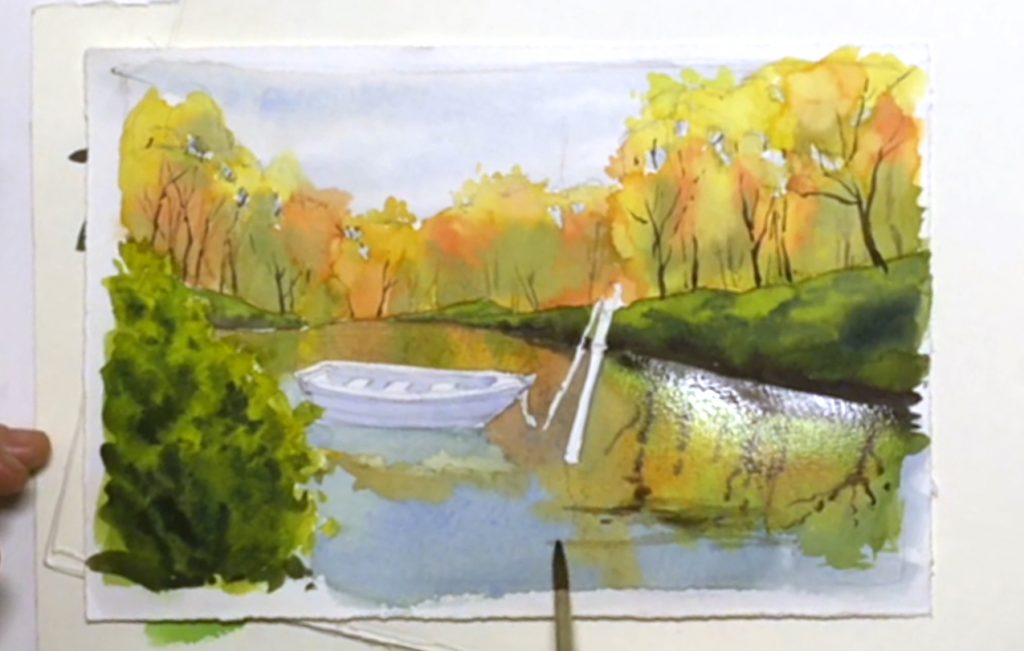 For the reflection of the rowboat, use a dampened clean brush to lift out paint directly underneath the boat. It shouldn't be too difficult as the paint should still be wet, but try not to brush too hard or you may damage the paper. Wipe lifted paint onto a paper towel, and zigzag the edges of your reflections a little to create a ripply illusion on the water's surface. Switch to the size 6 brush, and use the same muddy brown mixture to paint the reflections of the tree trunks and branches while the paper is still damp. Waver them a little to get a watery effect, and feel free to distort them even more as you move towards the front of the lake.
For the reflection of the rowboat, use a dampened clean brush to lift out paint directly underneath the boat. It shouldn't be too difficult as the paint should still be wet, but try not to brush too hard or you may damage the paper. Wipe lifted paint onto a paper towel, and zigzag the edges of your reflections a little to create a ripply illusion on the water's surface. Switch to the size 6 brush, and use the same muddy brown mixture to paint the reflections of the tree trunks and branches while the paper is still damp. Waver them a little to get a watery effect, and feel free to distort them even more as you move towards the front of the lake.
Step 14: Rowboat And Mooring Details
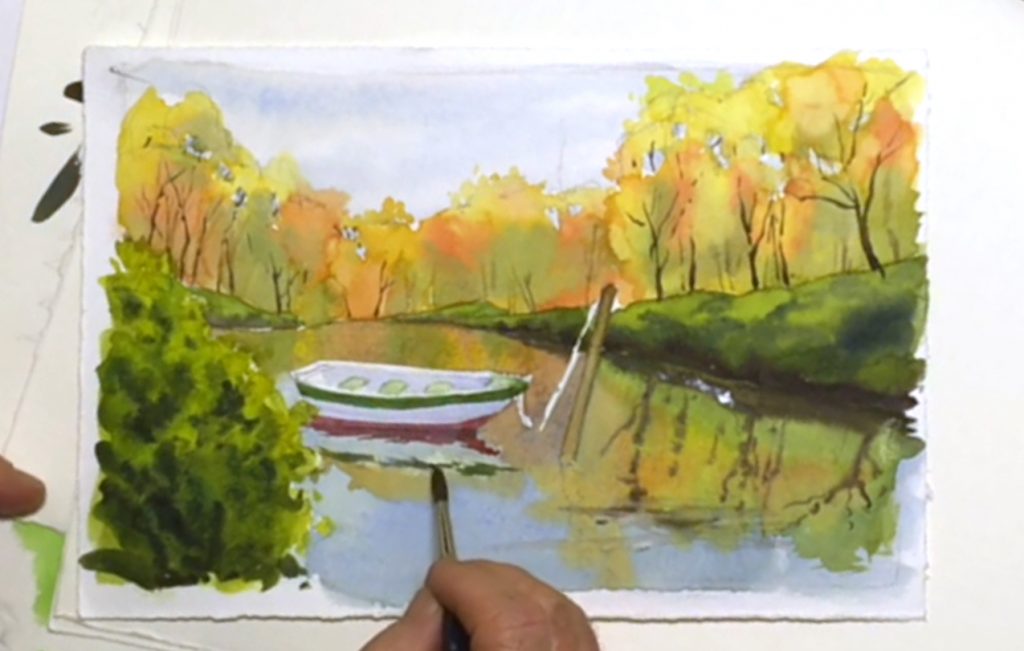 Finally, you are left with painting the boat's mooring. With the same size 6 brush and muddy brown paint, add some yellows and Burnt Sienna to create a wood-like color will make the post visually authentic. After painting it, use a clean brush to lift out a line of paint on the upper edge for a faint highlight created by the light source. Next, work on the boat’s details. Mix Hooker's and Cadmium Green Deep and paint along the rim of your boat to help it stand out. Leave the gunnels and hull white. Mix in more water with the dark green for a lighter wash, and fill in the seats with this pale green color for a bleached out effect due to direct sunlight hitting the surface of the seats. Complete the boat by mixing Alizarin Crimson and Cadmium Yellow Orange and painting a line just above where the boat meets the water. These stripes will be reflected in the water as well, and because of the boat's cast shadow and the fact that water is denser than air, the reflection should be a darker red and a darker green line that are also jagged to show the watery surface. You can fuzz the edge with a clean brush and include breaks in the line for a more distorted reflection, especially if the underlying layer of paint is a bit dry.
Finally, you are left with painting the boat's mooring. With the same size 6 brush and muddy brown paint, add some yellows and Burnt Sienna to create a wood-like color will make the post visually authentic. After painting it, use a clean brush to lift out a line of paint on the upper edge for a faint highlight created by the light source. Next, work on the boat’s details. Mix Hooker's and Cadmium Green Deep and paint along the rim of your boat to help it stand out. Leave the gunnels and hull white. Mix in more water with the dark green for a lighter wash, and fill in the seats with this pale green color for a bleached out effect due to direct sunlight hitting the surface of the seats. Complete the boat by mixing Alizarin Crimson and Cadmium Yellow Orange and painting a line just above where the boat meets the water. These stripes will be reflected in the water as well, and because of the boat's cast shadow and the fact that water is denser than air, the reflection should be a darker red and a darker green line that are also jagged to show the watery surface. You can fuzz the edge with a clean brush and include breaks in the line for a more distorted reflection, especially if the underlying layer of paint is a bit dry.
Step 15: Finishing Touches And Tuning Up
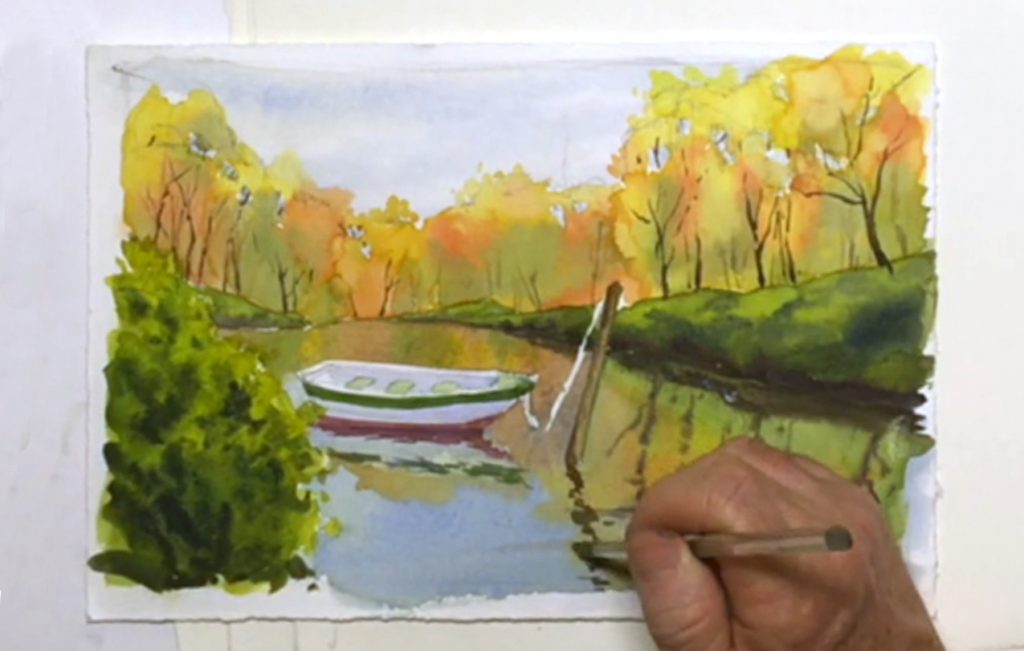 Darken the edge of the shadowed side of the post with another layer of the wood-like color used in the previous step, then paint the post's reflection in the water using a darker version of the wooden color (mix Ultramarine Deep, Burnt Sienna, and Alizarin Crimson). Have the reflection be more jagged and rippled than usual, since the post is quite close to the foreground of the painting. The small rope anchoring the rowboat to the post should also have a reflection, and since it's white, use the size 6 brush to lift out paint from the water while following the rule of mirrored images. Lastly, mix Permanent Violet and Ultramarine Deep, and paint the shadow on the edges of the seat slats inside the boat. This last part is more about what you feel could be better, and what you think needs to be added or fixed. Step back and take some time to study your painting as a whole, and see if there are any shapes to adjust, colors to improve, and any values or tones that need touching up.
Darken the edge of the shadowed side of the post with another layer of the wood-like color used in the previous step, then paint the post's reflection in the water using a darker version of the wooden color (mix Ultramarine Deep, Burnt Sienna, and Alizarin Crimson). Have the reflection be more jagged and rippled than usual, since the post is quite close to the foreground of the painting. The small rope anchoring the rowboat to the post should also have a reflection, and since it's white, use the size 6 brush to lift out paint from the water while following the rule of mirrored images. Lastly, mix Permanent Violet and Ultramarine Deep, and paint the shadow on the edges of the seat slats inside the boat. This last part is more about what you feel could be better, and what you think needs to be added or fixed. Step back and take some time to study your painting as a whole, and see if there are any shapes to adjust, colors to improve, and any values or tones that need touching up.
Step 16: Lifting Paint To Increase The Shimmer
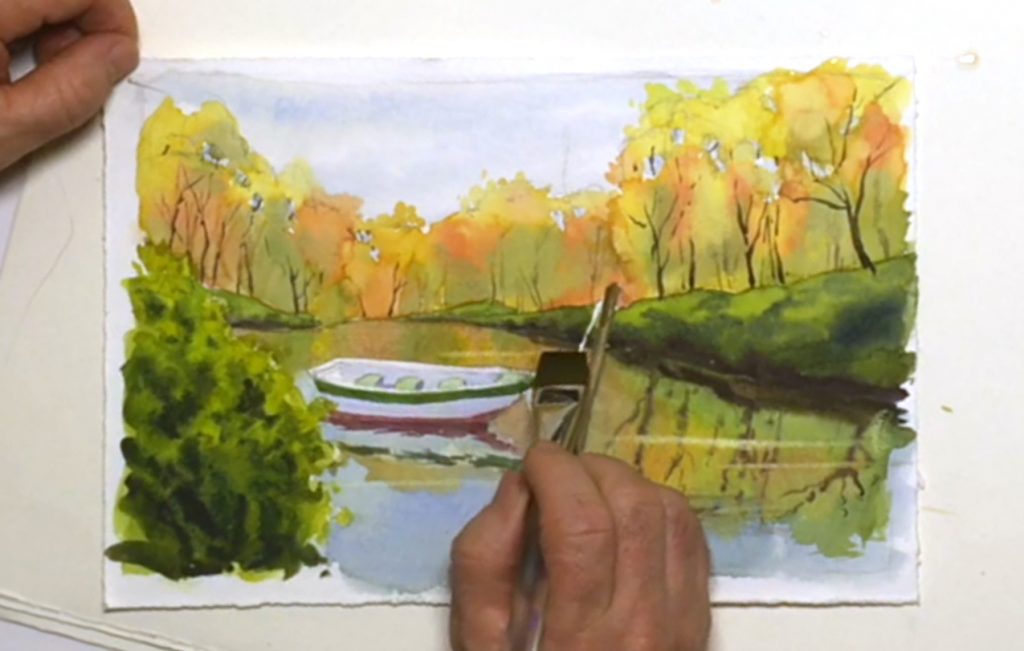 After the whole painting is dry, one final touch you can do is to use the edge of a dampened large flat brush to lift out horizontal lines on the surface of the lake. Make sure that the bristles are parallel with the horizon line to create the effect of light catching on a ripple of water. Again, wipe the lifted paint off with a paper towel, and try not to overdo it or you'll lose the peaceful atmosphere that a calm body of water creates. When you're satisfied with the overall picture, give yourself a pat on the back: you've just completed a wonderful painting!
After the whole painting is dry, one final touch you can do is to use the edge of a dampened large flat brush to lift out horizontal lines on the surface of the lake. Make sure that the bristles are parallel with the horizon line to create the effect of light catching on a ripple of water. Again, wipe the lifted paint off with a paper towel, and try not to overdo it or you'll lose the peaceful atmosphere that a calm body of water creates. When you're satisfied with the overall picture, give yourself a pat on the back: you've just completed a wonderful painting!



